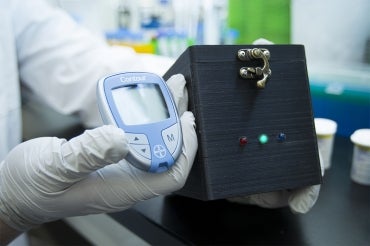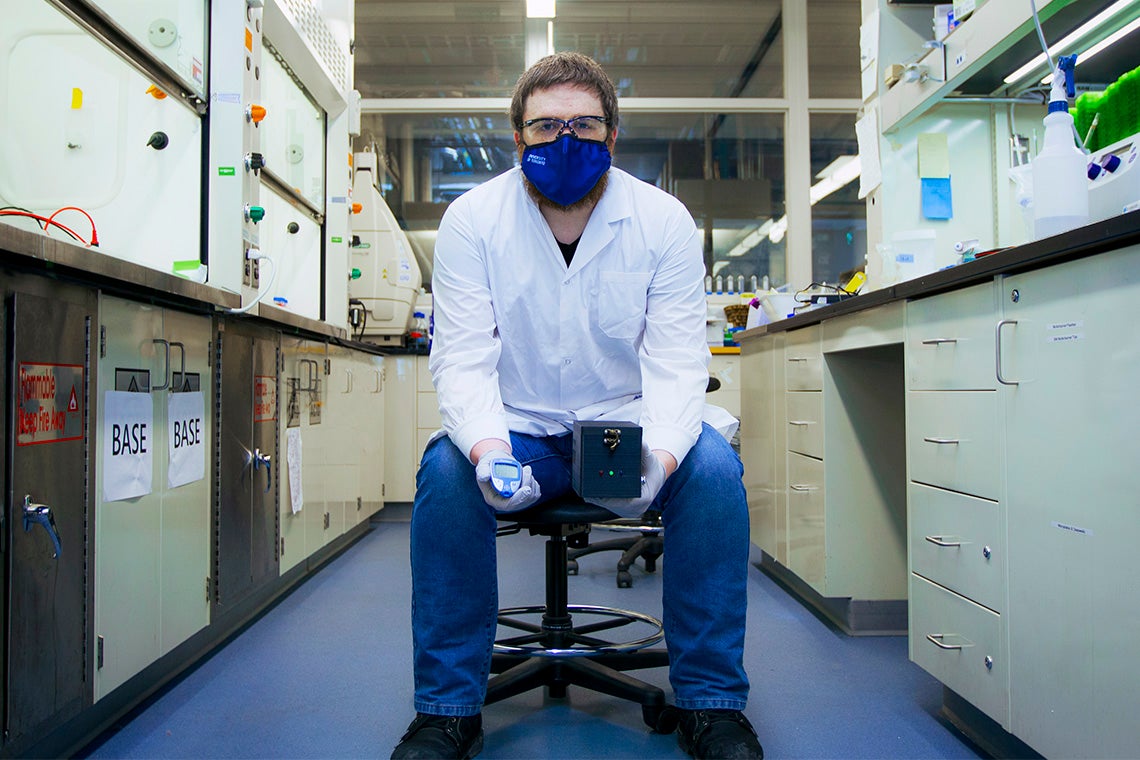U of T researchers adapt glucose meter to help detect diseases, including COVID-19

Published: February 1, 2021
Researchers at the University of Toronto, led by Assistant Professor Keith Pardee of the Leslie Dan Faculty of Pharmacy, have developed a point-of-care diagnostic test using a widely available glucose meter that can be adapted to diagnose a number of diseases, including COVID-19.
The new gene circuit–based system is described in a new paper published in Nature Communications.
“Advanced diagnostic tests, including COVID-19 diagnostic tests, require some specialized equipment that you really only find in a lab,” says Evan Amalfitano, a PhD candidate in Pardee’s lab and lead author of the study. “A commercial, off-the-shelf glucose meter is a lot cheaper and already widely distributed.”
Glucose meters are used to monitor the blood sugar levels of people with diabetes. The system relies on an enzyme, which interacts with an electrode to produce an electrochemical signal. The stronger the electrochemical signal, the higher the blood glucose level.
Yet, while the approach shows considerable promise, there is a significant amount of product development work needed before the technology could be moved from the lab and into the field. That could ultimately make the research of limited utility when it comes to battling the current pandemic, depending on how long it takes to get COVID-19 under control globally.
Pardee, an expert in synthetic biology, has developed several cell-free systems that can detect the genetic material of different pathogens, including Zika virus.
“We’re interested in extending access to health-care tools geographically to rural or northern communities, as well as globally,” says Pardee. “There’s also emergency health-care applications, including public health emergencies like what is happening now.”

Evan Amalfitano, a PhD candidate in Assistant Professor Keith Pardee’s lab, led a study that described a point-of-care diagnostic test using a widely available glucose meter (photo by Steve Southon)
Pardee’s lab has focused on developing systems that use optical signals, such as fluorescence or colour change, to indicate when the pathogen is present, but they recently began examining electrochemical signals to expand the applications of these systems.
Amalfitano began studying how to generate electrochemical signals in cell-free systems early in his PhD program, with Pardee calling Amalfitano’s idea to take advantage of the existing technology of the glucose meter a “home run.”
Because glucose meters are relatively inexpensive and accessible, they are an ideal platform to adapt for different purposes, especially tests that need to be done in remote or low-resource communities. Though it was a simple idea in theory, Amalfitano says it was challenging to get it working in practice – and that he was close to giving up on the idea when his perseverance finally paid off.
To use the system, patient samples are processed to extract and amplify the genetic material present. The sample is then tested for the pathogen’s genetic material. A type of genetic switch called a “toehold switch” is activated when it detects the target’s genetic material, producing an enzyme that generates glucose. The glucose meter measures the glucose level, which indicates whether the toehold switch was activated and the pathogen’s genetic material is present.
The team first demonstrated the system with artificial sequences of RNA. It then successfully developed a panel of tests for the bacterium that causes typhoid fever. Just as they were preparing to publish these results early in 2020, the COVID-19 pandemic started. So, the team considered applying their new technology to the emerging public health emergency.
Alex Green, a collaborator from Boston University, designed a toehold switch to target regions of the SARS-CoV-2 virus. The team was able to use the glucose meter to detect the virus in clinical samples – all within the space of just a few weeks. They are now working on streamlining the sample-preparation stage of the system to make it easier to extract the genetic material outside of laboratory settings.
“Because it is reasonably quick to adapt and the commercial inputs to adapt it are relatively inexpensive, the system reduces the technical burden for diagnostics development,” says Pardee.
“We’re hoping to increase the range of diagnostics that could be built for neglected diseases in low-resource regions of the world and for agricultural diseases.”
The research was supported by the Canadian Institutes of Health Research and the Natural Sciences and Engineering Council of Canada, among others.


